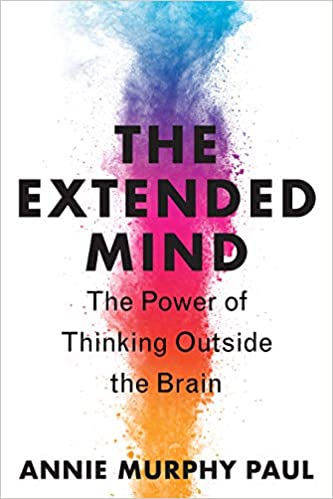What does writing look like? Chances are you are sitting and typing. Or sitting and pushing a pen across a page. And you are thinking, right? Thinking and thinking and thinking. Your brain is working on the plot, evaluating the words you used to describe your protagonist, and judging whether your big twist makes sense.
If you think harder will the words come out better? Will the plot improve? Will your characters leap from the page as full 3D beings if you can just … think a little harder?
Hmmm.
I give you Annie Murphy Paul. She’s the author of The Extended Mind: The Power of Thinking Outside the Brain. I have yet to read the book, but Paul wrote about the general concepts in an extensive and interesting New York Times column here.
As Paul points out, we’re coming off a period of forced isolation, thanks to the pandemic, when we’ve been relying on our brains to work. Continuously. No coffee breaks. No lunch breaks. No commutes.
Are you feeling depleted? Distracted? Unequal to the tasks? Paul, who studies this stuff for a living, says we are up against “universal limits” on the biological brain. “Despite the hype, our mental endowment is not boundlessly power or endlessly plastic.”
And the world we are in expects the brain to shine. For the past century, daily life has become more “cognitively complex,” Paul asserts, and “less grounded in the concrete and more bound up in the theoretical and abstract.”
Thank you, Einstein. And quantum physics.
And, yes, I.Q.’s have climbed over the last century (though it now appears to have leveled off).
It’s possible we now know that technology can handle stuff—and handle it readily. No need to remember, say, telephone numbers.
The cool thing about Paul’s work is to recognize the other thing we’ve got going for us in the “thinking” department.
Our bodies.
“Fortunately, there is an alternative. It entails inducing the brain to play a different role: less workhorse, more orchestra conductor,” she writes.
This is a field known as “embodied cognition” that has demonstrated the body—its sensations, gestures, and movements—plays “an integral role in the thought processes that we usually locate above the neck.”
Paul’s New York Times column dives into much more detail and I’m sure the book goes even further.
But she notes that the body is “especially adept” at alerting us to patterns of events and experience, patterns that are too complex to be held in the conscious mind.
Note:
“When a scenario we encountered before crops up again, the body gives us a nudge: communicating with a shiver or a sigh, a quickening of the breath or a tensing of the muscles. Those who are attuned to such cues can use them to make more-informed decisions.”
In short (in my head, at least), Paul is making a great case for hands-on learning. She makes a case for drawing and sketching problems as a way of solving them—of putting an issue in three-dimensional space in any way you can.
“When we turn a problem to be solved into a physical object that we can interact with, we activate the robust spatial abilities that allow us to navigate through real-world landscapes. This suite of human strengths, honed over eons of evolution, is wasted when we sit still and think,” she writes.
What can writers do to “embody,” so to speak, this concept? Well, one of my favorite scenes in all crime fiction is when American novelist Sydney Bartleby, who is living in England, decides to go through the motions of murdering his wife and burying her body. He literally rolls up a carpet, drives it out into the woods, and digs a hole. He wants his body to know what it feels like to have done the deed. (Of course, complications ensue when she disappears.) The novel is A Suspension of Mercy by Patricia Highsmith; also available as The Story-Teller.
Why not act something out? Have you ever sat at your writing space and pretended to throw a punch or pull back the string on a bow and arrow?
Oh, and Paul makes a great case for not thinking alone. Thus, writer’s groups. Thus, beta readers. Thus, RMFW Colorado Gold and shooting the breeze over a tart paloma. Now us solitary folks know why we like to conference. (Yes, it’s a verb.)
“Vigorous debates, engaged with an open mind, are the solution,” states Paul.
Paul fairly trashes today’s education and training—which prioritizes the notion of sitting still, working quietly, and thinking hard. Don’t we all know, deep down in our own bones (right?), that learning is more than thinking hard and storing up a bunch of useless facts in your head.
So, the next time you’re writing, if your brain is going in circles and not getting anywhere, give your body a chance. It might know.
It all kind of makes me wonder: when Annie Murphy Paul gets stuck writing, what does she do? I assume it’s not ‘think harder.’


Thanks, Mark! I just listened to Ezra Klein’s interview of Paul about this book and a lot of the information resonates with my own experiences of creativity being heightened on breaks from work (moving through space, being outside, or in the shower). And how we twist our faces into the expressions our characters will make in order to feel their emotions. Definitely good information for writers!
https://podcasts.apple.com/us/podcast/our-workplaces-think-were-computers-were-not/id1548604447?i=1000529445434
Thanks, Dani. Much appreciated. Thanks for the link, too.
Thanks, Mark! My method as well! I act out choreography, have conversations between characters while walking pups, swimming laps, or listening to novel’s play list on an elliptical, then data dump notes ahead in the manuscript when I get back to my laptop.
“Listening to novel’s play list on an elliptical….” Love this. You make a play list for your WIP? That’s awesome. On Spotify or some such?